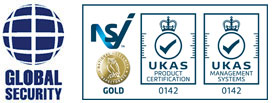Whilst brought to the forefront over the past five years due to the increased importance of temperature monitoring and infection control, thermal screening has been a major part of security systems for decades.
The main reason for this, besides its specific uses in health and safety, is that infrared sensors and cameras can detect living beings and movement around a facility in some instances and low-light conditions that night vision cannot.
Whether used for broad surveillance or as part of specific individual screening, thermal imaging has become essential, but part of the reason why this is the case is that the technology is far older than many people expect.
Television And Thermal Technology
In the 1920s, during a time when the television and closed-circuit surveillance were invented, the Hungarian engineer Kalman Tihanyi was working on similar but more forward-thinking technology.
Whilst infrared scanners had been used in civil applications over a decade earlier as part of iceberg detection systems for steamships, Mr Tihanyi’s system combined infrared scanning with his far more advanced television system relying on charge-storage and cathode ray tubes.
This system was superior to the pioneering systems of John Logie Baird and Leon Theremin, and one of the patents had been sold to RCA to form the iconoscope.
However, he would be invited to London to develop a variation of his television technology that would be used by the British Air Ministry.
Thermal Radioscope
Part of this broad work involved an aerial weapons guidance system, which included radio-guided weapons and lock-on homing technology, but also included an adaptation of his radioscope television technology.
He developed an infrared-sensitive camera system that could be used to help guide this unmanned aircraft, known at the time as an aerial torpedo. This technology was also adapted for the Italian Navy.
The technology was fairly broad, but would initially be used as part of an anti-aircraft defence system in the UK.
During the latter part of the First World War, a major threat was bombing runs by airships, and so any form of early warning system was highly desired by the British Air Ministry.
Eventually, many of the systems as part of Mr Tihanyi’s patent were so influential that a lot of them continued to be used in the production of early drones and UAVs until the latter part of the 1980s.
This early thermal imaging system, alongside the similarly secretive invention of radar in the 1930s and 1940s, led to a rumour spread by the British Air Ministry that British pilots were eating carrots to help them see in the dark.
During this time, infrared was used to detect camouflage, although it would lead to the development of anti-infrared paints that mimicked the effect, which would lead to faster and more effective films being developed throughout the war.
It would take a very long time for other countries to catch up to Mr Tihanyi’s invention, however; in 1947, the US military developed a thermal imaging camera which took over an hour to develop a single image, barely more effective than the commercially available infrared film cameras.

Leave A Comment